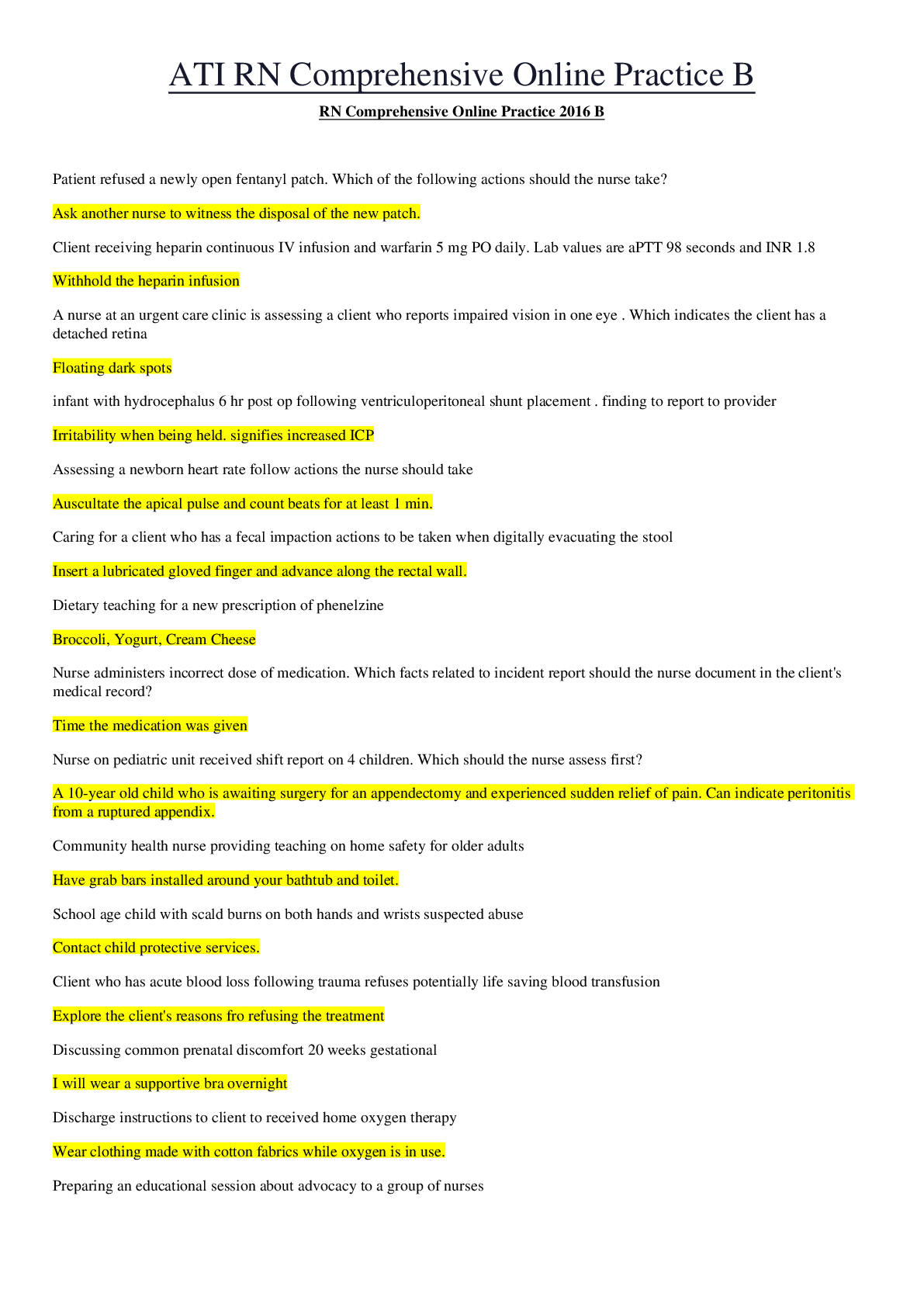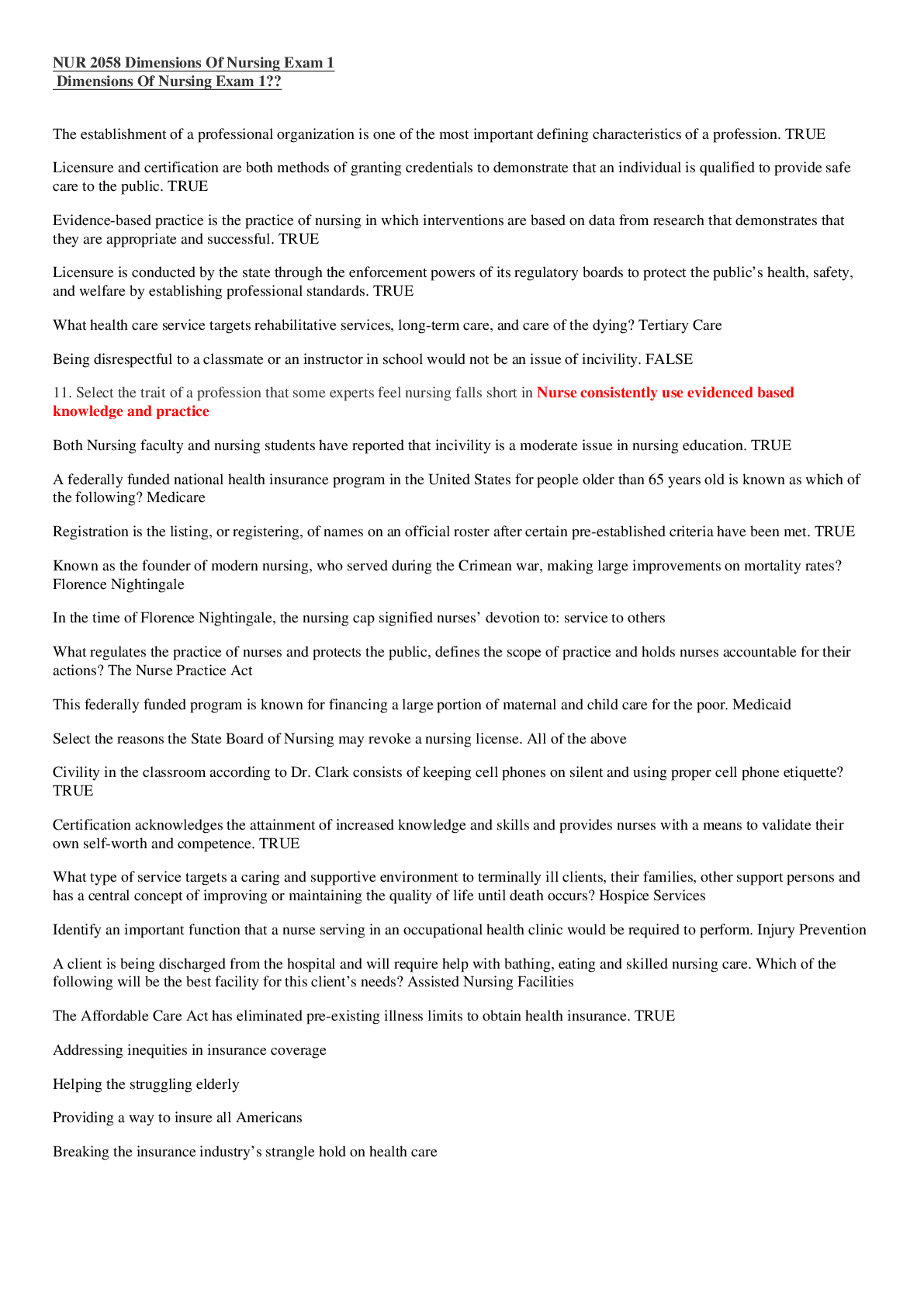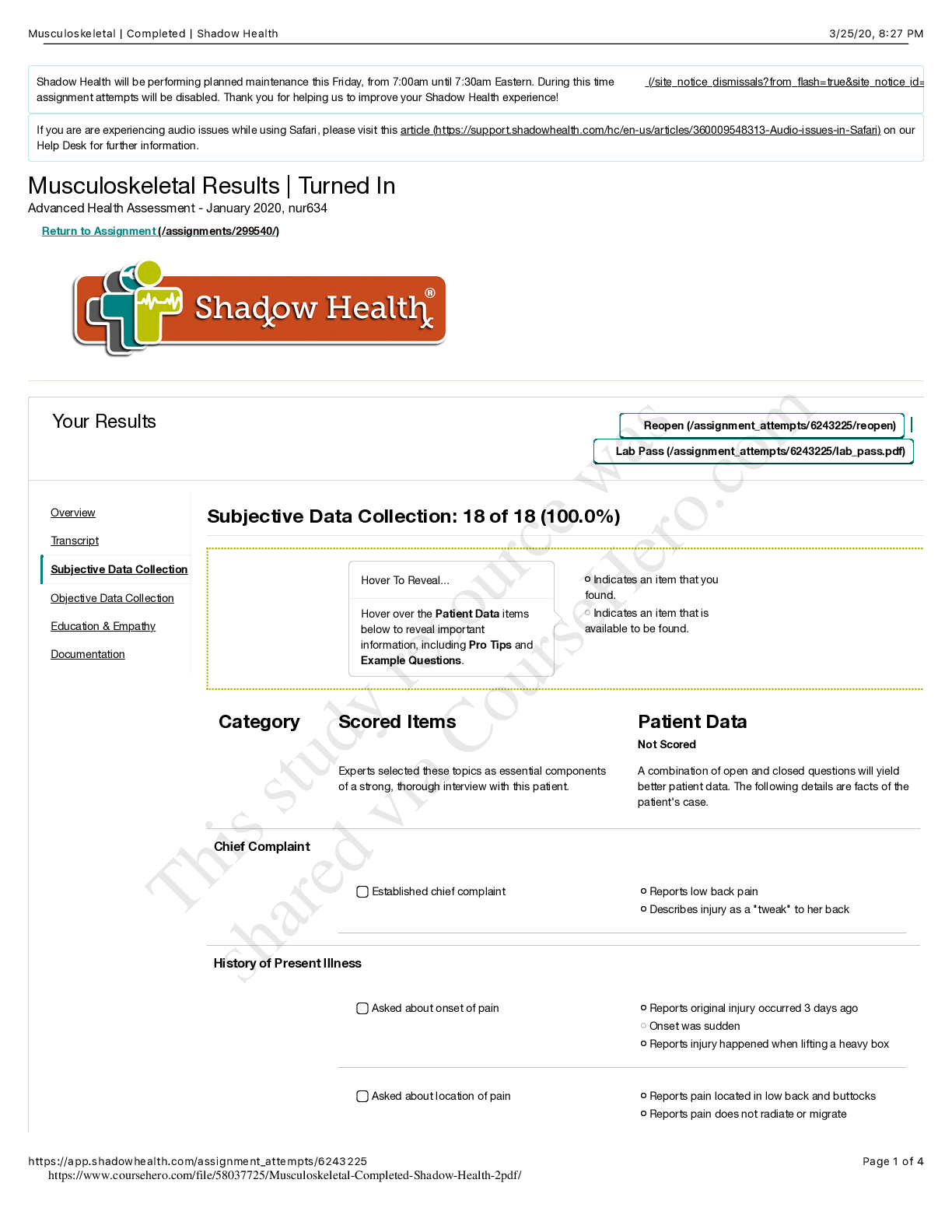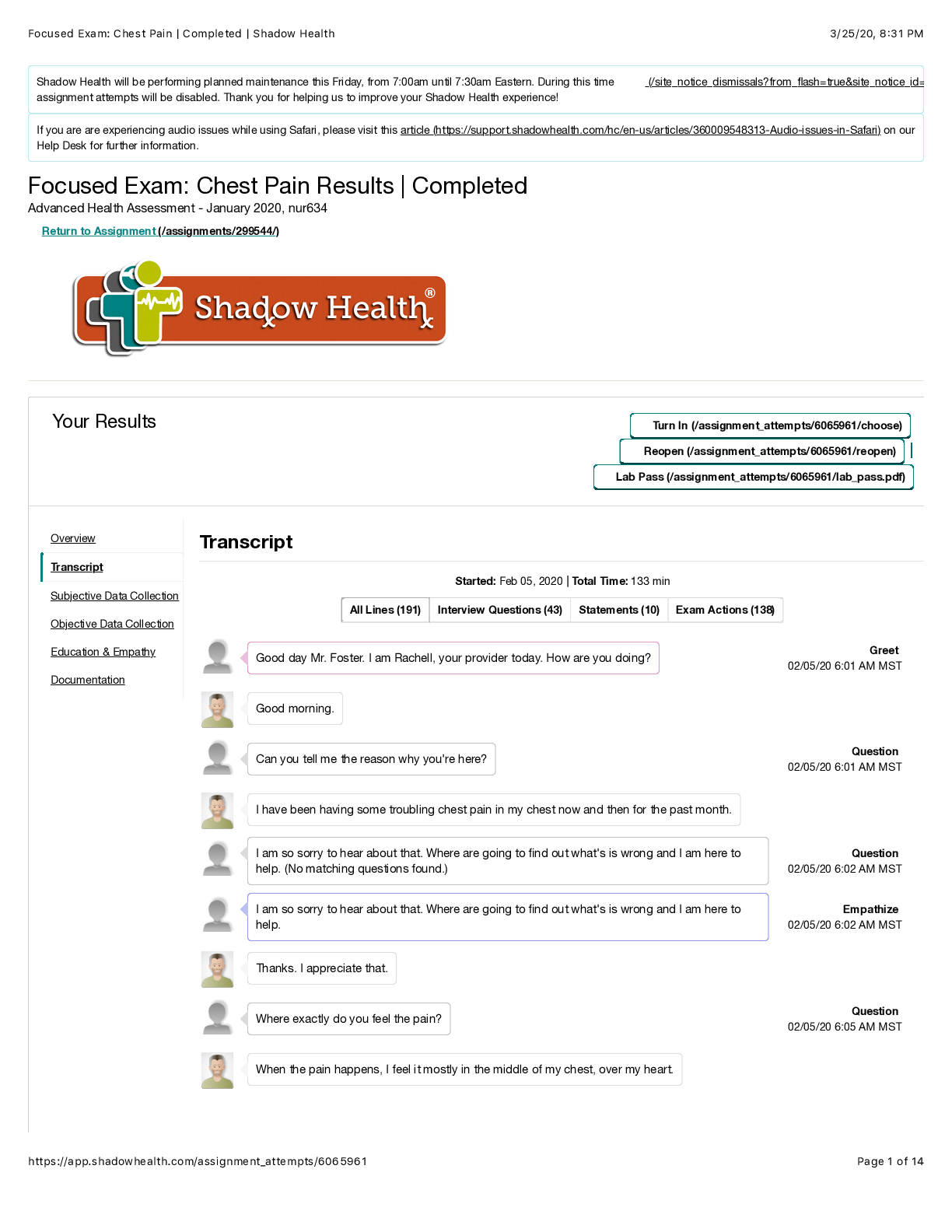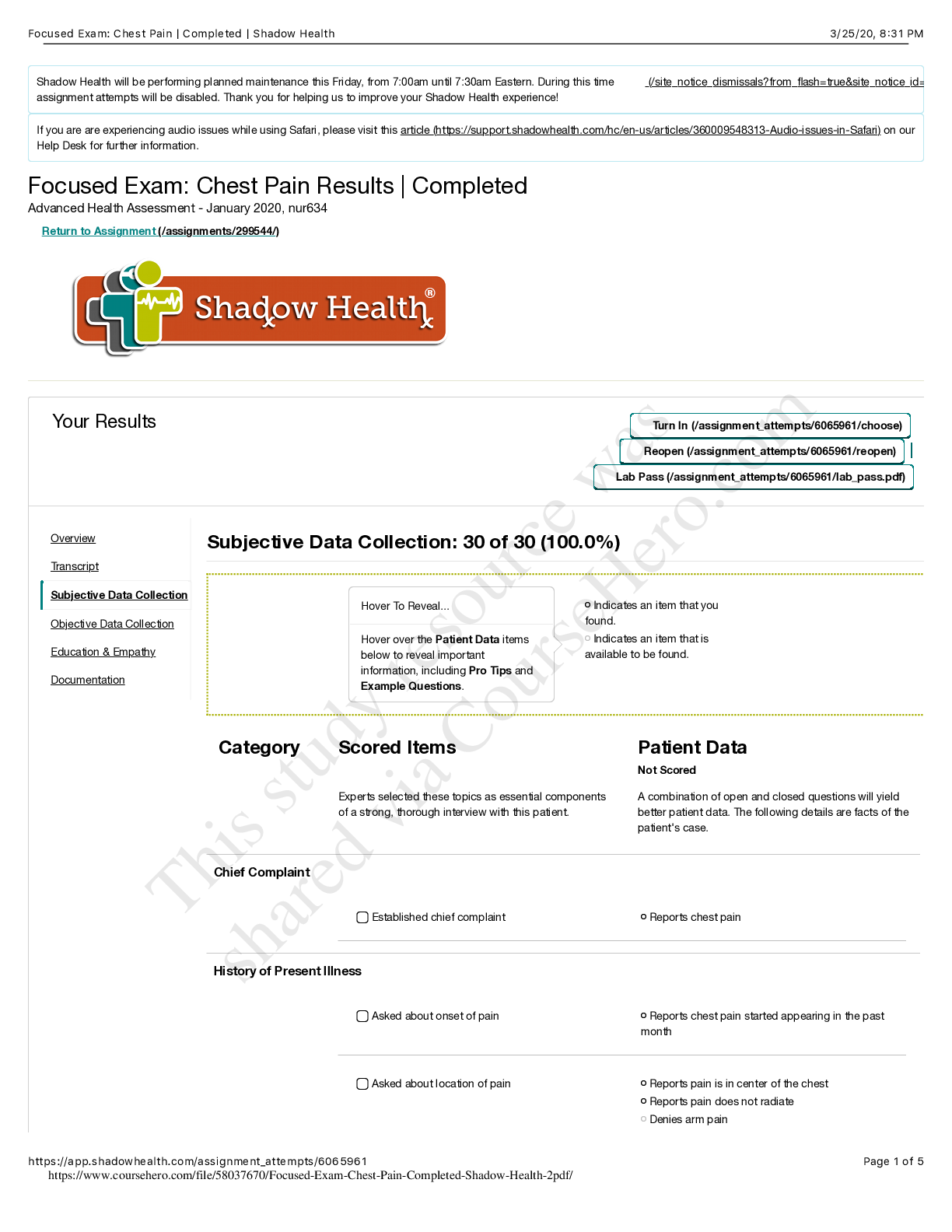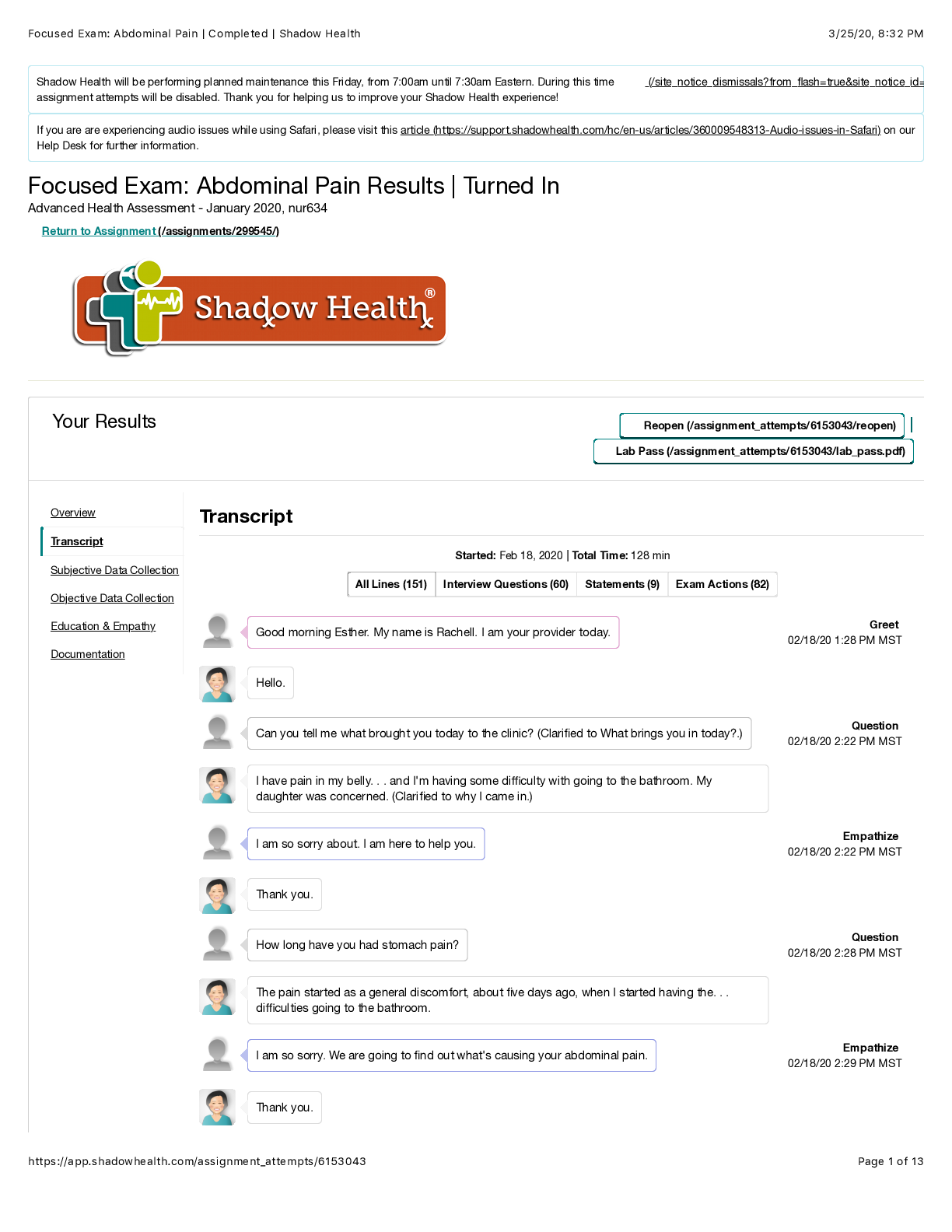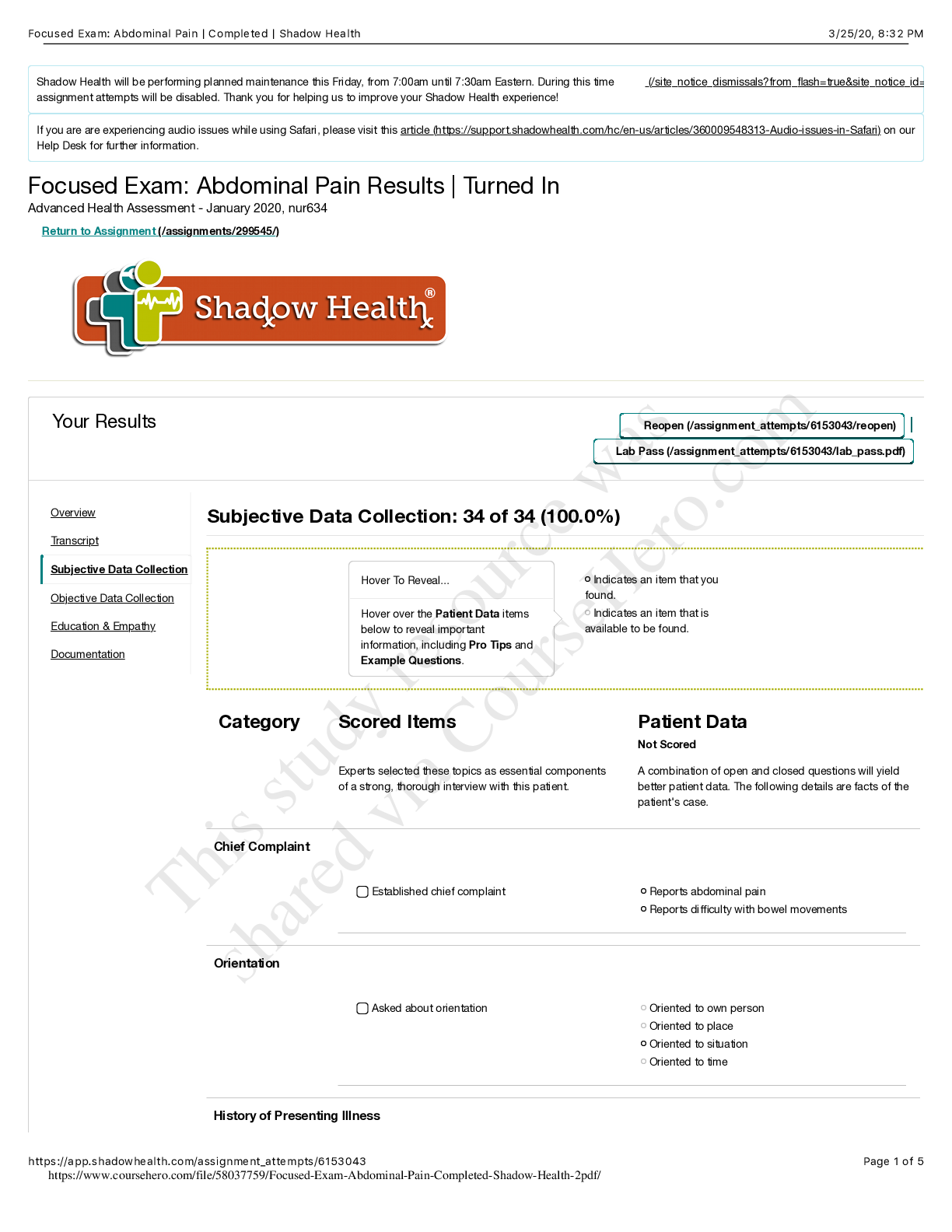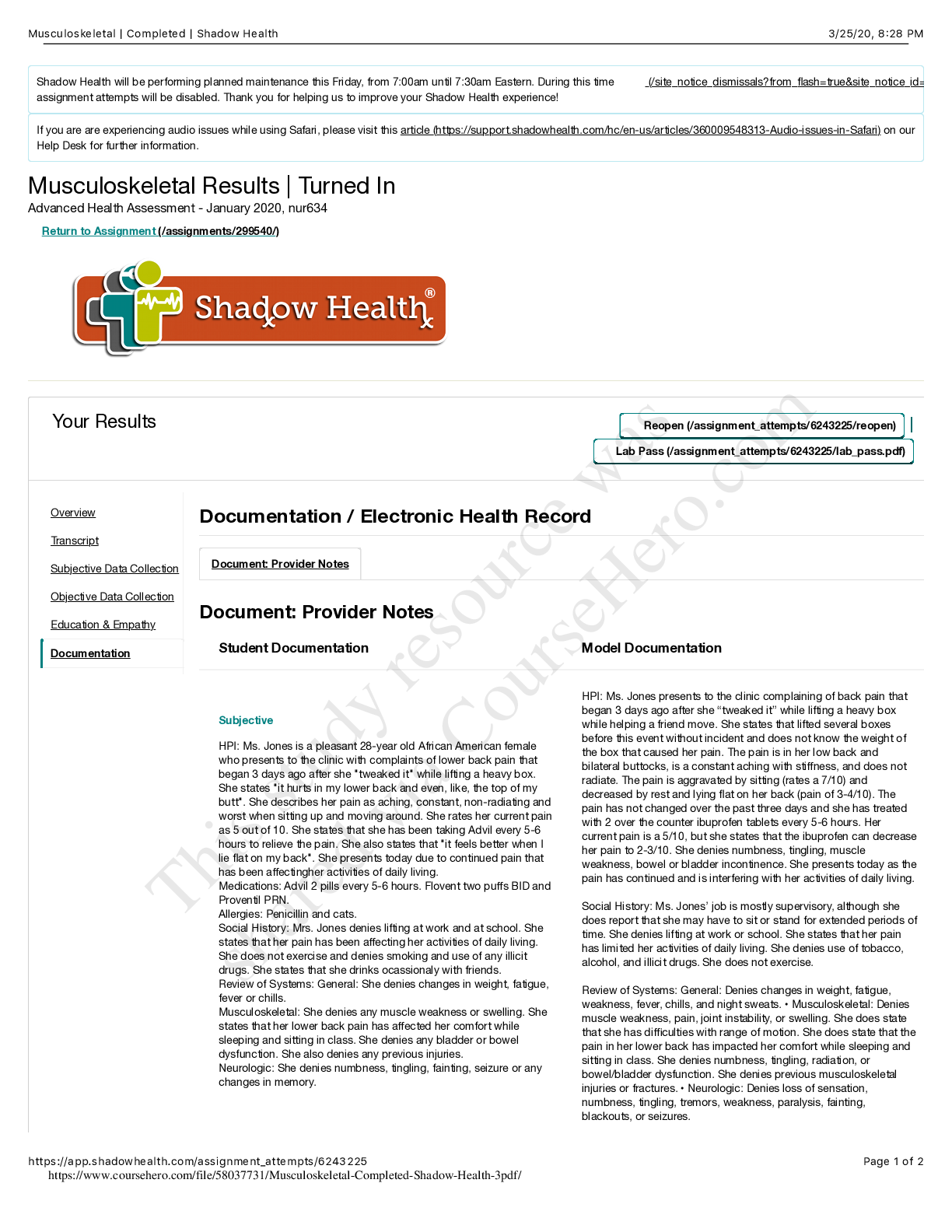*NURSING > EXAM > NUR 550 Fundamentals of nursing exam (2020) – Gateway Community College | NUR550 Fundamentals of n (All)
NUR 550 Fundamentals of nursing exam (2020) – Gateway Community College | NUR550 Fundamentals of nursing exam (2020)
Document Content and Description Below
NUR 550 Fundamentals of nursing exam (2020) – Gateway Community College FINAL EXAM Contemporary Nursing Practice • Nurse derives from Latin: nutricius = to nourish; nutrix = nursing mothe... r • Florence Nightingale — mother of modern-day nursing, called it an “honorable profession.” In 1868, declared nursing “The act of utilizing the environment of the patient to assist in his recovery.” • American Nurses’ Association (ANA) — “Nursing is the protection, promotion, and optimization of health and abilities, prevention of illness and injury, alleviation of suffering through the diagnosis and treatment of human response*, and advocacy in the care of individuals, families, communities and populations.” (2003) * human response = fever, trouble breathing, etc. Responses to human illness or other conditions. • The Connecticut Department of Public Health mandated that nursing as a profession has a “separate and distinct body of knowledge” than doctors, etc. Again focused on human response, alleviating suffering, and preventative care. • Core values/sub-concepts of nursing: 1) Critical thinking — collects, identifies, examines, interprets & evaluates data — allows for independent thought, and initiating thoughtful action — mitigates the nursing process 2) Safe/competent practice — based on scientific principles; evidence-based — clinically, culturally & technologically competent and safe — the application of theory to practice 3) Caring — enhances the dignity & integrity of others — encompasses, empathy, advocacy, listening, being culturally competent & respecting the humanity and diversity in every person 4) Professionalism — values the uniqueness of nursing; are connected to the profession — develops skills & furthers education over time — has integrity, maintains confidentiality — is collegial; aware of role-development and “politics” 5) Communication — verbal, non-verbal, in-person or with technology — uses information technology for learning & documentation — no small talk; use therapeutic communication to establish the relationship & glean good information designed to be a part in the healing process 6) Holistic care — the sum of the whole is greater than its parts (i.e., the person with diabetes, not the diabetic) — there is a wellnessillness continuum; people need care across their lifespan, including spiritually a. Health promotion = helping pt get to higher level of wellness b. Health maintenance = helping prevent/reduce risks of illness c. Health restoration = helping pt return to highest state of wellness that they can • 3 nursing schools opened in the 1870s; originally, nurses went to school and then worked for free. Since the 1950s, Mildred Montag was the first person to propose an Associate’s Degree RN education. In 1965, it was established that nurses should be educated in an academic, multi-disciplinary setting (not just hospital-based education). ~ Nursing shifted from procedure-oriented to critical thinking and evidence-based for best practice. In the 1970s, the ANA published a position paper on nursing education declaring all students should receive a BSN. Currently, there are four levels of education: 1) Associate Degree (developed because of nursing shortages) 2) Diploma education 3) BSN 4) Graduate degrees a) Clinical Nurse Specialist (advanced degree in specific area — oncology, diabetes, geriatrics, pediatrics, etc.) b) Nurse Practitioner (advanced degree; can practice independently; has some prescribing privileges; usually outpatient 5) healthcare — family, peds, etc.) c) Certified Nurse Midwife (both a nurse and a midwife; NP-level; independent) d) Certified Registered Nurse Anesthetist (accredited for anesthesia) e) Nurse Educator (in nursing schools; staff/patient education in hospitals) f) Nursing Administrator (more managerial) g) Nurse Researcher (investigate problems to improve/further/define nursing) • Functions/roles of nursing: ~ Caregiver/comforter: physical & emotional care to patients, families & communities; sets realistic goals & meets them using minimum amount of time & energy; is holistic: looks at psychosocial, spiritual, etc. ~ Advocate/protector: maintains safe environment (with allergies, preferences, etc.), human dignity and legal rights (esp. if can’t do for themselves) ~ Educator: help people achieve optimal level of wellness; explain, work through, and let know what will be best for their health/wellness; detail medications ~ Communicator: provide effective nursing care b/c allows patient to make right decisions; patientnurse communication = most important ~ Manager: coordinating members of the entire healthcare team ~ Clinical decision maker: determines priorities of care based on nursing clinical judgment and processes Health Protection • Resident flora = microorganisms found in our bodies; typically don’t cause illness except if body is tired/weak/sick/susceptible, and microorganisms are particularly virulent in their point of entry. • Bacteria are most common infection-causing agents. Viruses can only grow within a living host/cell. — Hepatitis is most virulent; infects healthcare workers. A, B, C, D, E, F, G. “If it starts with a vowel, it comes from the bowel.” All other transmit via blood. • MDRO = multi-drug resistant organisms. Ex: MRSA, VRE (vancomycin-resistant Enterococcus), ESBL (extended-spectrum beta-lactamase-producing) and C. diff (Clostridium difficile) • Microorganisms produce infection depending on: a) # of microorganisms present b) pathogenicity (what conditions/resources need to survive) c) ability to enter the body (via wounds, needle sticks, breathing, etc.) d) susceptibility of the host (most at risk: hospitalized, elderly & pediatric patients) e) ability to live in host’s body (if conditions/resources need to survive are present) • Infections can be localized (in pustules, etc) or systemic (diarrhea, etc). Can start local and enter the blood stream and become systemic. Transmitted by touch/air/etc. — the “iceberg effect” = we are all colonized; what rises above are infections. — best defense against infection = hand hygiene. — infection chain: all must be present for infection to occur. At least one must be rendered harmless or destroyed to remove a link from the chain. causative agent reservoir exit portal mode of transfer entry portal susceptible host Causative agent = any microorganism or biologic agent capable of causing disease. Reservoir = places microorganisms are found. Ex: infected wounds, feces, animals/insects, contaminated food/water, equipment, people (love because dark, lungs easy entry/exit, liver b/c of moisture, blood supply b/c of pH 5-7, temperature 96-100.4) Portal of exit = route by which pathogen leaves. Prevent spread by treating & handling excretions properly. ~ waste (GI tract) ~ mucous/droplets/breath (respiratory tract) ~ open wounds/secretions (skin) ~ urine/semen/discharge (GU tract) Modes of transfer = direct contact with body excreta/drainage; indirect contact with contaminated inanimate objects/vectors; droplet infection. To prevent: wear gloves, clean skin b/f injections, hand hygiene, sterile/disinfected area & equipment, and education. Portal of entry = eyes, mouth, nose, trachea, skin, mucous membranes. (Same to exit.) Susceptible host = age (pedi/geri), health state (sick, diabetic), broken skin (surgery, ulcers). Prevent by aseptic technique, isolation, immunizations, raising immune systems, living conditions, hygiene, nutrition and lifestyle. — Elderly are particularly susceptible due to: a) immobility leading to poor hygiene leading to skin breakdown/illness b) chronic or multiple illness compromising the immune system c) physiologic changes like thinner skin (higher infection risk) d) poor nutrition or dysphagia (difficulty swallowing) leading to lack of teeth/dentures, and lowered immune system — Elders have altered pain and febrile response so they don’t notice illness in prodromal stage. They will have altered physical/emotional/systemic states. Elders have a lower baseline body temperature, so 100.4 to an elder is much “higher” than 100.4 to a young adult. Fevers lead to confusion in elders, so confusion is usually the first sign of an infection. • Stages of infection: 1) Incubation period = bacteria/pathogen enters; no s/s 2) Prodromal stage = onset of nonspecific s/s (fatigue, malaise, etc.) 3) Illness stage = s/s specific to particular infection 4) Convalescence = recovery/resolution of s/s • First lines of defense against infection: intact skin (inside & outside), saliva, tearing, blinking, cilia, GI secretions, and normal flora. Second lines: a) Fever = slows growth of most pathogens; other defenses mobilize b) Leukocytosis = leukocytes engulf invader c) Phagocytosis = phagocytes remove cellular debris & metabolic waste products and destroy bacteria/viruses — elevated WBCs indicate bacterial infection — non-elevated WBCs but fever indicate viral infection. — if superficial, inflammatory response = localized protective response (b/c of tissue injury/destruction) triggers BVs to dilate bringing +blood to area, causing erythema, warmth and edema to neutralize/destroy harmful agents, limit spread to other tissues & prepare damaged tissues for repair. • S/s of localized infection: edema & erythema, pain/tenderness with palpation or movement, palpable heat, loss of function in affected body part. • S/s of systemic infection: fever, increased pulse/resp. rate, malaise, fatigue, anorexia, nausea/vomiting, enlargement & tenderness of lymph nodes (esp. in throat) that drain areas of infection. • Asepsis = without infection. Aseptic technique includes practices and procedures to reduce the rate of infection or contamination. — medical asepsis = clean (i.e. gloves) — surgical asepsis = sterile (i.e. PPE) Also, hand hygiene/sanitizers, cleaning of beds/rails/equipment and identifying clients at risk. To break chain of infection: wear gloves/gown/mask & properly dispose biohazards. • HAI = healthcare associated infection (results from delivery of health services in facility). Patients at greater risk: multiple illnesses, elderly, malnourished, immunocompromised. Ex. surgical site infections (SSI). ~ Iatrogenic = HAI infection from a diagnostic or therapeutic procedure (i.e., look down throat to see lungs, get infection). Ex. Catheter-associaed UTI (CAUTI), central line-associated blood stream infection (CLABSI) — exogenous = infection from outside normal flora — endogenous = normal flora is altered & causes infection ~ Risk factors for HAIs: # of HCW in direct contact with pts, # of invasive procedures (IVs, catheters, etc.), therapy received (respiratory, physical, etc.), and length of hospitalization. ~ HAI sites: surgical/trauma wounds, urinary & respiratory tracts, bloodstream. • Methods of transmission: 1) Direct contact transmission = person to person by touch 2) Indirect contact transmission = contaminated object (sneeze on bedrails) 3) Droplet transmission = coughing, sneezing, up to 3-6 feet (varicella, measles, influenza, pertussis, etc.) 4) Airborne transmission = in air current for long distances, direct. Inhaled. (TB) — Some viruses may be transmitted by more than one route. Ex: norovirus particles can be airborne from emesis, or inhaled or swallowed from droplets. — For direct/indirect contact precautions, use gown/gloves, put on PPE before enter room and remove before exit room, patient in a single room, contain/cover infection site before transport. — For droplet precautions, PPE before entry and removal before exit, face shield or goggles/surgical mask. — For airborne precautions, put TB/measles/varicella pts in a neg. pressure room with non-recirculated air, surgical/N-95 masks. ~ It’s important to pay attention to the psychosocial needs of patients on isolation. Sensory deprivation, decreased self-esteem (visitors afraid to come), lonely, depressed, angry feelings. • Based on the principle that all blood, body fluids, secretions, excretions (except sweat), non-intact skin and mucous membranes may contain transmissible agents, presume or assume contaminated until know it’s not. • Glove use: work from clean dirty, limit opportunities for touch contamination, don’t touch self/PPE with gloves, don’t touch environment unless necessary during patient care. • To prevent HCW from getting infected, be up to date on immunizations, use aseptic technique, PPE equipment, and watch environmental controls. Use 200% accountability for hand hygiene. — If exposed, encourage puncture/laceration to bleed & wash with soap & water; flush mucous membranes for 5-10 mins; report & seek evaluation/follow-up. Safety • Joint Commission 2014 safety goals: ***identify patients correctly***, improve staff communication, use medicines and alarms safely, prevent infection and mistakes in surgery, and identify patient safety risks. • QSEN definition of safety/competency: “Minimizes risk of harm to patients and providers through both system effectiveness and individual performance.” • Factors affecting the ability to protect from injury: 1) Unmet basic physiological needs a) oxygen = hemoglobin loves carbon monoxide, and will quickly attach to it b) nutrition = need to refrigerate food and have food supply c) temperature = not too high or too low d) humidity = 60-70% 2) Age and development (particularly children and the elderly) 3) Lifestyle (living environment, alcohol or drug use) 4) Mobility and health status (respiratory disease, etc.) 5) Sensory or communication impairment (hearing/visually, diabetic neuropathy leading to decreased sensation in extremities) 6) Cognitive awareness (Alzheimer’s lack of sleep, medications) 7) Emotional state (depression or anxiety) 8) Lack of safety awareness (particularly children or confused patients) 9) Environmental factors/physical hazards (clutter, poor lighting, small rugs, cords, being in an unfamiliar environment) • Common potential hazards for newborns/infants: - temperature regulations - suffocation - formula problems/poor nutrition/choking - burns - disease To prevent, educate parents on cribs, sleeping positions, keeping baby warm, Heimlich maneuver, small hazards, bottle feeding/preparation, immunizations, and hand hygiene. • Common potential hazards for toddlers: - burns - falls - choking - electrocution - drowning To prevent, toddler-proof, watch hot surfaces, lock up poisonous substances, cut small foods, swim lessons. • Common potential hazards for preschoolers/school-age children: - stranger danger - illness - playgrounds/bike accidents - home fires To prevent, educate children on strangers, illness prevention, playground/bike safety. Preventing home fires: - teaching about matches/lighters - have working fire extinguishers and smoke detectors - have emergency numbers posted and a plan for evacuation/reuniting If a home fire occurs, stay low/crawl under smoke to prevent inhalation, close doors and windows, and cover mouth and nose. • Common potential hazards for adolescents: - drugs - firearms - sex - bullying - driving - smoking/alcohol To prevent, teach defensive driving/seatbelt use, education and communication about sex, knowing their friends, setting internet rules/controls, and modeling good behavior. Educate on firearm safety, keep guns locked in a non-glass case with bullets elsewhere. • Common potential hazards for older adults: - motor vehicle crashes and pedestrian injuries - burns - falls To prevent MVAs, evaluate whether it is safe for elder to drive. Elders are susceptible to burns because they are less sensitive to temperature — leading to thermal injuries. (Be careful of using therapeutic heat, test water before use, adjust the thermostat, educate on sun protection.) Watch for frayed cords/overloaded sockets to prevent electrical hazards. To reduce fall risk, assess patient’s age, sight and hearing, mobility, sensory impairments and history of falls, cords, furniture sticking out, clutter, small pets, throw rugs, stairs. Any fall in hospital that results in injury must be reported to a national database. In hospital: a) beds in lowest position, wheels locked, 2-3 rails up b) watch for fall hazard alerts (bracelets or signs) c) frequent toileting (1/hr) d) put needs close to them e) call button accessible and workable • Restraints are NOT a solution; they are a temporary last-resort means to maintain patient safety. (Physical: jacket/wrist restraint. Chemical: anti-anxiety med/etc.) — Complications = loss of self-esteem, skin breakdown, circulation/ROM problems, frustration, lack of movement (leading to constipation), death — Alternatives = get a sitter, staff interactions, try calm/patience, distraction or small jobs to keep busy, respect their routines • Always note in which room, esp. if in situation where need help (i.e. controlled falls) • If fire, R-A-C-E: Rescue patients in immediate danger, Sound the alarm, Contain the fire (shut doors/windows), Extinguish the fire. If bioterrorism suspected, detect & report. Vital signs • Vital signs monitor functions of the body: temperature, pulse, respiratory rate, blood pressure, O2 sat, pain. (In this order.) — Assessed at admission/discharge/physician’s orders, change in conditions, before/after procedures or transfers, at patient’s request, and before certain meds. • Body temperature = regulated by the hypothalamus; inside is “set point” that tells body what temp it should be. Normal is 98.6- 100.4 F (36-38 C). ~ Heat production is done by shivering, basal metabolic rate, and the thyroid (hypERthyroidism causes hot sweats). ~ Heat loss is done by sweating, radiation (environmental, like room temp), conduction (direct contact between an object losing heat and what’s receiving it, like person/bed), convection (airways, like wind, fans, etc.) and evaporation (sweating, liquid turns to gas which cools down). ~ Infants unstable, must be kept warm to prevent hypothermia ~ Children tympanic or temporal artery sites prefered for checking temp ~ Elders BMR is lower; worry more if higher temp —Factors influencing body temperature: 1) age (newborns unstable, elders lower) 2) Circadian rhythm (temp highest 3-6pm) 3) stress and exercise (raises w/ moving muscle) 4) hormonal activity (i.e., hot flashes) 5) external environment (hot air raises temp) 6) internal environment (thinness lowers temp, obesity raises temp) 7) gender (men have higher temp b/c of muscle mass) 8) diet (very spicy foods raise temp) 9) medication (Tylenol lowers, other meds raise) —Main sites: Surface = oral, axillary. Core = tympanic membrane, temporal artery, rectal. —Fever/febrile = above 100.4 F —Afebrile = normal 96.8-100.4 F —Hyperthermia = body producing more heat than losing —Phases of fever: a) set point raises shivering to raise surface temp to meet core temp; feel cold b) plateau phase surface temp meets set point c) sweating/flushing to get rid of heat; set point resets Nurse must figure out if fever is raising (shivering) or lowering (flushed/sweating). Intervene at 102 F. Ask pt how doing, check chart to see last temp, check frequently. — Weigh risks/benefits of trying to lower fever. Risks of not: seizure, lowered body function. Benefits of not: higher set point kills bacteria. To intervene, give patient warm blankets, monitor for signs of infection (labs or lungs), hydrate/remove blankets especially during third phase (diaphoretic). Last give Tylenol or abx if needed. — Educate patient: watch the temp outside, limit exercise if ill, keep up w/ fluids (no alcohol), wear light loose-fitting clothes. —Hypothermia = temperature under 96.8. S/s low temp, shivering, feeling cold, HR & resp. rate up initially to try to warm the body up but switches & starts shutting down. ~ risk factors: thin, poor nutrition; economic status (homeless); newborn/elderly; burns/trauma; alcohol use; poor circulation. ~ to treat: warm blankets, raise room temp, warm IV fluids before put in, wear hat, position limbs close to body, keep patient dry (esp. if incontinent). • Pulse/Heart rate = wave of blood created when the left ventricle contracts. (Sometimes HR is higher than pulse/there is no pulse in extremities, esp. in elderly.) Normal is 60-100 beats per minute (in newborns is 110-140). —Factors influencing HR: 1) age (lowers with age) 2) gender (men have higher b/c of more muscle) 3) exercise (raises during, lowers overall) 4) temperature (raised temp = raised pulse) 5) medications (always check pulse before give meds) 6) blood volume (if blood volume lowers, pulse raises at first to compensate, like if hemorrhage) 7) emotions (stress raises) 8) Postural change (lying down lowers, sitting/standing up raises) Infants: 50% have heart murmurs that are not pathological Children: apex is located in 4th or 5th intercostal space Elders: often have decreased peripheral circulation; run cool —Main sites to check and reasons to: a) temporal (if pounding headache; in children) b) carotid (during CPR or change in mental status) c) apical (cardiac murmur, or if detect irregular radial pulse; in newborns) d) brachial (to check blood pressure; during CPR in children) e) radial (main site; if irregular, check apical) f) ulnar (if radial is busy and to check flow before doing anything brachial) g) femoral (to check flow to legs; during CPR) h) popliteal (to check blood pressure or flow to legs) i) posterior tibial (to find blood flow to feet) j) dorsalis pedis (to find blood flow to toes; important in diabetics) ~If can’t find a proximal pulse, check distal! —Characteristics of pulse: normal is 60-100, tachycardic >100, bradycardic <60 bpm. Listen for equality of beats and interval between beats; can be regular, regular-irregular, or irregular-irregular. Strength is rated weak/absent (0) to bounding (4+); 2+ is typical. Always compare to corresponding artery if abnormal (at the same time, except carotids). • Respirations = breathing, controlled by respiratory centers in the pons and medulla oblongata; and chemoreceptors found in the medulla, carotid and aortic bodies. - ventilation = inspiration/expiration (chest wall moves) - diffusion = O2 gases come in, CO2 gases go out - profusion = goes with blood flow; O2 comes in, RBCs grab & take through body. RBCs pick up CO2 and take back to lungs to go out. —Factors affecting respiratory rate: 1) exercise (initially raises, lowers overall) 2) stress/pain/anxiety (raises) 3) smoking (raises) 4) body position (lying down lowers, sitting/standing up raises; if trouble, put pt at 45 degree angle; if in severe distress put in “tripod”) 5) medications (check resp. rate before administering) 6) neurological injury (resp. centers are in brain so if TBI check respiratory!!!) 7) hemoglobin function (poor profusion tissues need more O2, resp rate raises) 8) environmental temperature (higher temp = higher HR) Infants: some newborns display periodic breathing; is normal Children: are diaphragmatic breathers Elders: anatomical & physiological changes cause resp. system to be less efficient —Components of respiratory assessment: a) Rate = 12-20 bpm (check secretly when checking pulse); tachypnea >20, high/fast; bradypnea <12, low/slow b) Depth (shallow, deep, normal, labored) c) Rhythm (regular/irregular) d) Quality (is patient struggling to breathe? If no, doing good quality breaths) e) Effectiveness (use pulse oximeter to check if O2 is transporting and CO2 is eliminating well) ~ pulse oximetry is non-invasive, calculates pulse oxygen saturation (SpO2), which estimates arterial blood oxygen saturation (SaO2). Normal = 95-100%; <70% is life-threatening. Checking pulse oximetry detects hypoxemia before clinical s/s. If rate is low, ask pt to sit up and take deep breaths. Check what that pt’s normal rates are (could be low if COPD). check fingers in adults and feet in newborns nail polish, artificial nails and movement interfere with light transmission; cold feet/fingers and decreased blood flow interfere with arterial pulsations. - - - - - - - - - - - - - - - - - -- - - - - - - - - - - - - - - - - - - Treating depressive disease (doctor)/treating response (nurse): Medical Nursing: assess, teach and intervene using Maslow with: Determining diagnosis Mood Prescribing treatments Eating and sleeping patterns Antidepressants, medications, electro-convulsive therapy (which is making a comeback)*, psychotherapy, and level of safety monitoring Cognition Monitoring progress Medication administration, teaching, effectiveness Safety ECT produces electrical impulses in the brain to “scramble” them. • Nurses do mental status exams to determine pt’s basic level of consciousness (a+o x4) and mood/affect (verbal & non-verbal). - mood = a pervasive and sustained emotion that colors a person’s perception of the world. - affect = an immediately expressed or observed emotion. Ex: affable, “appropriate to context,” flat, labile (changeable or wishy-washy) -“mood is to affect as climate is to weather,” so mood determines affect & is the global picture/concept around it The MSE’s primary use when done during a physical exam is to assess cognition, emotion and behavior. It gathers data formally (with lab data/vital signs/test results) and informally (what we see, hear, and ask about). Used by Mds, SWs, RNs and OTs, etc. It does take time, and is dependent on patient condition (always maintain safety). It can reveal a need for a comprehensive and focused exam if something seems off, like the presence of speech difficulties, intellectual or cognitive impairments, and the reason for the exam (forensic, disability, etc). - elements: appearance, behavior/movement, speech, emotions (mood/affect), thoughts (content/process), perceptions (hallucinations/illusions), cognition (LOC, orientation, memory*, attention/concentration, abstract thinking, judgment & insight**) * memory: we have 3 kinds, short, long & immediate. We do have memories to smells, sights, and music. ** how pt relates to/copes with what’s going on with them. - we want nurses to have critical thinking judgment, not just concrete judgment here. - if you hear any sort of threat to self/others, don’t walk away from it — pursue it! And ask the right people for help. • Using tools and scale with mental health evaluations: the subjective nature of many mental health problems requires tools and scales to identify and quantify a patient’s symptoms. Basic tools and scales can be used as a screening tool to determine if follow-up is needed, like the pain scale. Purposes: a) to track progress or decline of a condition when administered at time intervals b) to identify the ranges and severity of a problem c) to help identify the effectiveness of interventions, or the need to change tactics - Advantages: objectivity, tools & scales are well-tested (requiring for them to be utilized in a clinical setting assures reliability, consistency and validity of results). It can improve assessment data if patients are non-verbal, and many can be taken independently by the patient to save time. Clinical interviewing is difficult and requires practice & skill, and while tools & scales will not replace a clinical interview, they’ll provide additional data and place less reliance on interviewing skills. - Disadvantages: some people are less accurate reporters on an inventory sheet, and using tools and scales does require knowledge, training and interpretation. It does not replace an interview and some people feel less connected to their treatment. ~ The nurse’s role is to know who the tool is designed for, know patient criteria that supports the use of a certain tool, know what method to administer, know what the results mean and have a plan to deal with the findings. ~ CAGE screening = Have you ever felt you should Cut down on your drinking? Have people Annoyed you by criticizing your drinking? Have you felt bad or Guilty about your drinking/ Have you ever had a drink first thing in the morning to steady your nerves or get rid of a hangover (Eye-opener)? (1 = possible, 2 = yes) • Psychosocial assessments help with pt perceptions, important factual data, info obtained that has a major impact on planning care and resources (but be careful, b/c never know if you can trust answers a patient gives so check with partner/family/etc.). Basically used to ascertain the background of the pt in conjunction with the MSE and physical exam. Assesses psychiatric, educational, occupational, personal, sexual patterns, alcohol/substance use, medications, vitamins & herbal use, coping, legal & violence issues and spirituality. • Erikson’s stages of development for adults: 1) Generativity vs. stagnation = middle adulthood, 40-65. Patient has enough life lived to be able to evaluate life, and there’s still time to make changes. a) generativity = person feels concerned for what he/she generates or contributes to the world b) stagnation = self-absorption concerns so narrow that pt has no concern for anyone or what he/she contributes 2) Ego integrity vs. despair = late adulthood, 65+. When individual looks back at life lived. a) ego integrity = healthy self-concept with self-esteem but not self-absorption b) despair = resulting in sadness/depression over life lived, or anxiety over impending end - Nursing implications: pts lacking/having a sense of accomplishment/achievement often influences pt’s attitudes and feelings of hope during health challenges. Asking pts about their lives, families, accomplishments and disappointments allows a richer understanding of those we care for. - Interventions: life review, use of therapeutic communication techniques (like open-ended questions, empathy, clarifying, and paraphrasing) • Emotional symptoms are often a result of physical health problems, and their consequences include loss, uncertainty and fear. This requires coping, therapeutic communication by the nurse, referrals to outside help, and consideration of the quality of life. They are dependent on others in many ways (from completely dependent to mostly independent). • Anxiety = uncomfortable, tense, uneasy emotional state, resulting from a perceived or real threat. A universal experience known to all, and varying widely from mild to moderate, severe, and panic (panic attacks). Physiological signs of anxiety: increased HR & RR, shallow, rapid breathing (not blowing out enough CO2, palpitations, decreased cardiac output leading to lightheadedness, fainting. - Nursing implications: assess for the subjective and objective indicators of anxiety, understand the implications of managing clients with different levels of anxiety, see how it impacts the overall health condition of the patient and mobilize/utilize resources and supports, know and assess for the physiological effects of stress and anxiety, and know the basic methods to help manage anxiety, both pharmacological and non-pharmacological techniques: guided imagery, distractions (music, movie, humor), breathing into a paper bag, bathing, back rubs, walking, calling the chaplain or family - Managing anxiety: ***listen*** actively and attentively, focus on the here and now, use touch when appropriate. Maintain safety, explain procedures, treatments and tests, explore coping mechanisms, use distraction and/or relaxation techniques or methods, and use PRN meds. • Post-traumatic stress disorder = a reliving of a traumatic experience; can occur if experienced or witnessed a traumatic event outside the range of normal human experiences. Ex: military combat, catastrophic natural disasters, assault or rape, life-threatening medical diagnoses, or motor vehicle/other severe accidents. - Symptoms may occur right after or be delayed (re-experiencing the traumatic event through flashbacks or nightmares, sleep problems, being easily startled, distracted, moody, irritable or withdrawn; avoiding stimuli associated with the trauma; and physiological arousal fight-or-flight symptoms due to the release of adrenaline and epinephrine affecting sleep, concentration and mood. - People with PTSD can feel easily intruded on — so require a slow, reassuring, sensitive approach. - Nursing implications: identify at-risk people, known symptoms of PTSD and identify client cues indicating guarded behavior or discomfort with a physical exam. Be careful not to re-traumatize the person; establish trust and go slowly. Do NOT ask people to recount the traumatic event. Assist with coping problems (like sleep). • Depression = common low mood responses to any negative situation or event (loss, role change, illness, etc). Anhedonia = you just can’t feel good about anything, no pleasure (opposite of hedonism = pleasure-seeking). Clinical depression/major depressive disorder = a severe low mood that persists 2+ weeks, affects ability to work, socialize or carry out normal roles effectively; is biologically-based with neurotransmitters serotonin, dopamine, epinephrine and norepinephrine, can be genetically-linked and is under-diagnosed. Symptoms: changes of sleep pattern (too much or too little), decreased or increased appetite, and poor concentration. - Nursing implications: individuals are at risk for suicide and may be poor at managing their health problems. Follow up on any negative or ambiguous statements (may indicate suicidal thoughts). Consider the ability of depressed individuals to manage both medical and self-care. Use empathy, keep them “here and now” focused, and don’t dwell in the past. • Substance abuse = from a person with an addictive personality, is the use of a legal or illegal mood or brain altering substance despite negative physical, legal, occupational, or recreational consequences. Can be as innocuous as caffeine and as harmful as cocaine. Withdrawal symptoms are life-threatening for both the patients and the providers. Include: shakiness, sweatiness, visual/auditory hallucinations, headaches and disorientation. - Nursing implications: it’s common in the health care settings for people throughout their life spans. It’s not always revealed in the health history — denial is the most common symptom. Risk factors include the environment or genetics. The physical and emotional health of the client is impacted, and families/supports can be affected too. People get frustrated and deny there is a problem. Nurses are pivotal in accessing help, but nurses and doctors themselves have high rates of substance abuse. Nonjudgmental approach is key! • Loss and grief = it’s a part of life that challenges us personally and professionally. Helping clients manage their loss and grief is intense, delicate, emotionally charged, and can be very rewarding. Look at whether it’s normal or pathological grief, and the grief effects: physical and emotional well-being, behavior, spirit, alteration in body image, inability to cope, and loss of role in family. Elizabeth Kubler Ross wrote “On Death and Dying,” including the 5 stages of grief. - Tasks of grief: to accept it, to acknowledge the emotional pain, to adapt to changes and to even achieve personal growth through navigating a loss. - Goals of grief: to heal from the loss, and to recover and restore to the fullest level of function. • Resilience = the ability to recognize and manage negative emotions, and to develop and grow from stressors that challenge us. Positive coping enhances healthy hormone release that modulates stress hormones, making us heal and feel better. Resilience can be taught, but we can also become less resilient over time/experiences. • Stigma = a mark of shame, discredit or embarrassment; an identifying mark or characteristic. There are a plethora of stigmatized disorders, diseases or conditions. People are afraid they have something awful and are afraid to get help, or don’t talk about their diagnoses because of the stigma, and feel very isolated and unhelpable. [Show More]
Last updated: 2 years ago
Preview 1 out of 168 pages

Buy this document to get the full access instantly
Instant Download Access after purchase
Buy NowInstant download
We Accept:

Reviews( 0 )
$30.00
Can't find what you want? Try our AI powered Search
Document information
Connected school, study & course
About the document
Uploaded On
Jul 09, 2020
Number of pages
168
Written in
Additional information
This document has been written for:
Uploaded
Jul 09, 2020
Downloads
0
Views
99





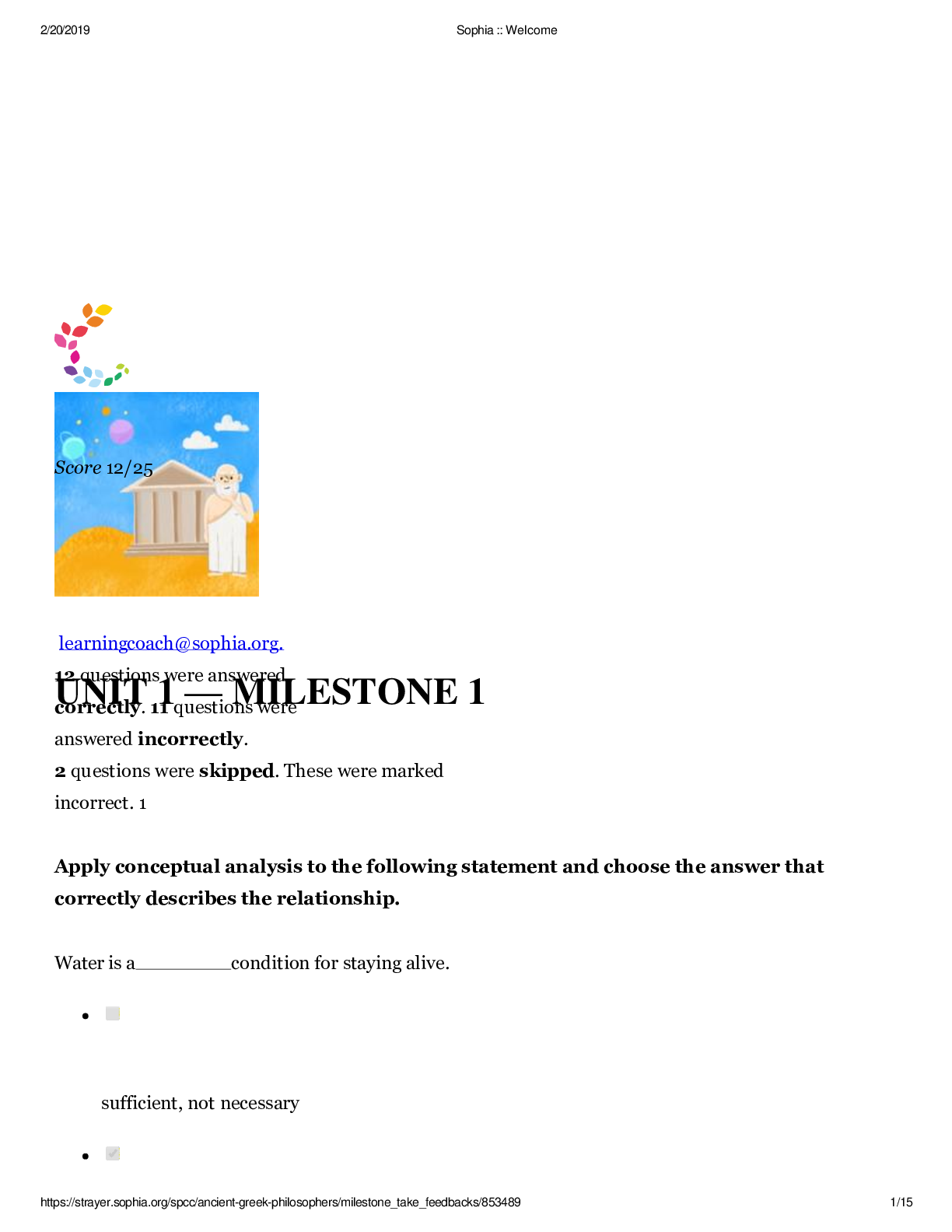


 – University of the People.png)
